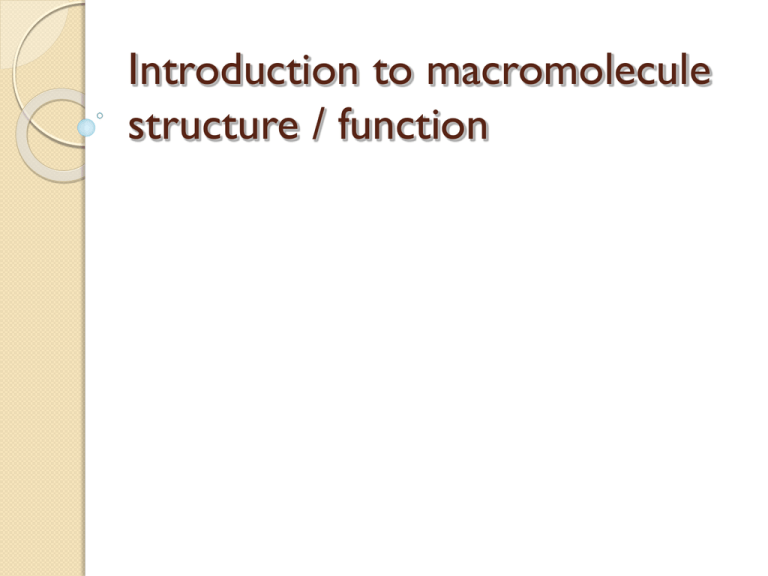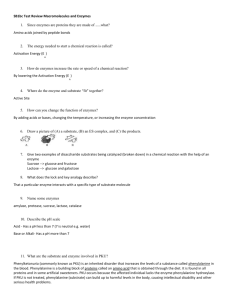macromolecules
advertisement

Introduction to macromolecule structure / function Macromolecule types 1) carbohydrates 2) fats 3) nucleic acids 4) proteins Big and small … Simplest unit = monomer Many monomers together = polymer Many can polymerize indefinitely (exception: fats) Putting together = dehydration synthesis Uses: storage, construction Reaction also produces H2O molecule (H and OH ripped off, combine) Dehydration synthesis Example: carbohydrate synthesis Example: peptide synthesis Example: DNA synthesis H2O Breaking up polymers = hydrolysis – using water to split a polymer (also splits water itself as H is added to one side, OH to other) Uses: digestion, defense, recycling Hydrolysis – general example Carb hydrolysis Macromolecule overview 1) carbohydrates Roots: –ose (not all the time) Components: C:H:O ~ 1:2:1 ratio monosaccharide is monomer Carbohydrate functions a) Quick energy ATP glucose glycogen – animals starch - plants unstable immediate usage fats (converted carbs) stable long-term storage Carbohydrate functions b) Structural support Cellulose – plant cell walls Chitin – fungal cell walls (also arthropod exoskeletons) Carbohydrate functions c) Cellular identification Glycoprotein – sugar ID tag attached to membrane protein – (we’ll study more in ch. 43 – immune system) Fig. 7.9d white blood cell recognizes ID tag by binding to it, does not attack this cell human body cell with carbohydrate ID tag Macromolecule overview 2) Lipids (fats – solid, oils – liquid) Components: CHO (lots more CH than carbs) fatty acids glycerol Fat synthesis can be repeated with two other fatty acids = triglyceride Lipid functions a) Energy storage b) Insulation c) Cell membrane component (phospholipids) Macromolecule overview 4) Proteins Roots: -ase (for many enzymes) Components: CHONS (sulfur present in certain amino acids) Monomer: amino acids Protein functions - EVERYTHING a) enzymes – speed up chemical reactions b) c) transport proteins – let certain materials in / out of cell motor proteins – move things around in cell d) receptor proteins – receives signals sent to cell e) transcription factors – binds to DNA to regulate protein production) (and more … this is just a sample) Protein structure / function How is diversity of function possible? How is specificity possible (each protein only interacts with one particular component)? Answer: each protein has unique conformation (= 3-D shape) to interact with particular component Protein monomer Amino acid abbreviation for the unique side chain of each amino acid ic acid How get a unique 3-D conformation? Must have unique combination of bonds that hold it in its precise shape We will talk about different types of bonds that form as a protein folds up 1) 2) 3) 4) Primary structure Secondary structure Tertiary structure Quaternary structure * Really important, please study carefully Primary structure = which amino acids combined in which order order prescribed by DNA code, constructed by ribosomes. type of bond formed: peptide bond this forms the polypeptide (which must fold into 3-D shape to be called a protein) Secondary structure Interactions between “core” parts of amino acids (amino and carboxyl groups) that used to be far away Type of bond: hydrogen bonding (O—H N—H attractions) Because all amino acids have these parts, repeated hydrogen bonding forms two possible shapes: α-helix or β-pleated sheet Secondary structure α helix Tertiary structure Additional bonds between side chain “R” groups of amino acids Many types of bonds possible (depends on R groups interacting) Amino acid interactions might seek out other polar AAs nearby and hydrogen bond (+) AAs might seek out (-) AAs and make ionic bonds Amino acid interactions might be pushed by water into clustering in a hydrophobic region Quaternary structure (Not all proteins) Sometimes overall protein = combination between multiple polypeptide subunits Type of bond: depends (probably hydrogen bonding) Result of all that bonding Uniquely shaped protein We will focus first on one subgroup: enzymes – bind to a specific substrate to speed up a chemical reaction Sample enzyme - sucrase Speeds up the hydrolysis of sucrose active site of enzyme 4. enzyme’s active site is open for another substrate molecule to collide (reusable) 1. enzyme and substrate molecules must collide 2. enzyme helps chemical reaction occur 3. product molecules do not fit well in active site, so they leave Environmental factors affect enzymes Also discussed in lab 2 introduction 1) temperature changes 2) pH changes 3) salt concentration changes Temperature and enzyme activity Below optimum (as it gets “cold”) , reaction rate drops because fewer enzyme / substrate collisions Enzymes do NOT denature in cold temperatures Temperature and enzyme activity Above optimal temperature, reaction rate quickly drops as heat energy breaks weak bonds holding protein conformation = denaturation Can no longer bind to substrate = zero activity pH and enzyme activity Unlike temperature, different enzymes have different ideal pH environments Too much H+ (too acidic) or OH- (too basic) can disrupt electrical attractions, bonds that give protein shape Salt concentration and enzymes Ideal salt concentration may differ for different enzymes also Salts may interfere with electrical attractions within protein structure (hydrogen / ionic bonding) Salt levels also affect water balance in cells Maintaining environments A balanced temperature, pH, and salt concentration must be maintained for protein activity (and survival) Using energy to maintain a balance = homeostasis Cell level homeostasis Overall body homeostasis = temp, pH and salt levels Cell regulation of enzyme activity Cells want to control overall enzyme activity a) regulate enzyme production levels (regulate DNA transcription) b) regulate how active these existing enzymes are Two types of inhibitors uninhibited enzyme (substrate can bind) competitive inhibitor – noncompetitive inhibitor – molecule directly blocks molecule binds to active site allosteric site and changes active site shape so substrate cannot bind Another example of binding site ATP often transfers a phosphate to binding site to activate protein Inhibitor / enzyme balance Most inhibitors bind weakly and reversibly to proteins Enzyme regulation = balance of inhibitors moving randomly, binding and falling off enzymes Many of the strongest poisons are irreversible protein inhibitors (ex: cyanide) Feedback inhibition Best inhibitor is often the end product itself Got enough product? = enzymes blocked Too little product? then few inhibitors = enzymes active





